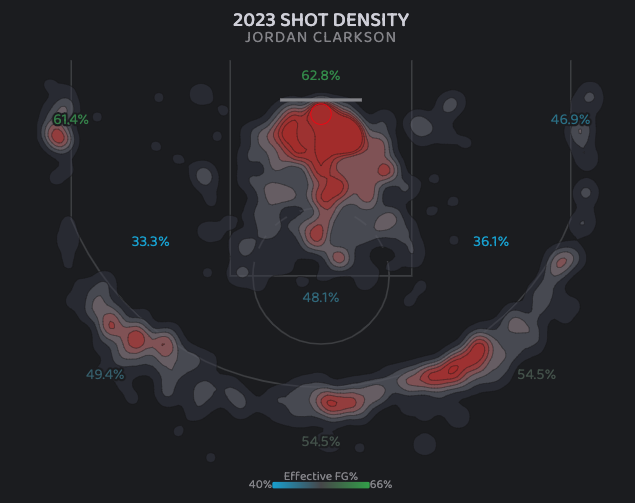Happy New Year, friends! I hope there have been some days of rest and rejuvenation for you as we turn the calendar over and start anew. Considering the tardiness of this post, it might be obvious that I was successful in unplugging and getting away from the tyranny of my computer for a bit. What have I been doing with that blissful time of solitude? Thinking about the Utah Jazz, mostly.
2022 has been a weird one for Utah. During this time, an era of sustained success ended. Quin Synder got the boot, stars were shopped and shipped, Danny Ainge came home. Following these significant steps of a teardown, a bonafide firesale wasn’t just expected, it seemed imminent. The 2022-23 season of Jazz basketball, conventional thinking went, wouldn’t amount to much more than a long, slow, painful march toward ping pong balls the promise of Victor Wembanyama.
Naturally, none of this has come to pass. As it turns out, Will Hardy can coach. A spirited team came out firing on night one, beating the Nuggets by 21, and has never looked back. Mike Conley still impacts winning, Lauri Markkanen rode the wave of a good summer of EuroBasket into a legitimate, All-Star breakout, and a fiery mix of competency and passion from non-stars up and down the roster has powered Utah well beyond conversations about tanking. The Jazz went 6-2 in October and 7-9 in November.
Then the NBA schedule did what the schedule does. Life on the road in the NBA, even in the early season, is tough. December held just five victories, all in Salt Lake, and the year ended in full meatgrinder mode. After taking care of the Wizards at home on December 22, Utah lost four games in six nights by deficits of four, five, one, and three – the last two a back-to-back set that started in Sacramento and ended with a New Year’s Eve disappointed against the visiting Heat.
The calendar flipped over with 19 wins in the bank along with 20 losses. Though under .500 for the first time all year, the live-dog Jazz still clings to the last play-in spot out west. And while the year ended on disappointing notes, Utah still finds itself way ahead of the sincere tankers (San Antonio and Houston) and the flailing try-hards (Minnesota and Los Angeles) in the Western Conference. It’s possible that they could fall out of the expanded playoff, but plummeting so hard that they crash into the Victor Wembanyama sweepstakes is all but off the table at this point. The low end of the East is every bit as bad as the West. The bottom of the league is simply too far below the Jazz to be caught.
How could this be?
Utah is a team of extremes, and watching their games is not dissimilar from watching sailors bail out a ship with holes in the bottom. The offense is legitimately elite, but the defense is so bad that every bucket on the other end is vital. This is something of a familiar refrain out west, as both the Kings and Nuggets are pulling in better results through a similar build, though neither is as tilted as Utah. Scoring 116.2 points per 100 possessions is tremendous, only the Celtics are more efficient offensively, but they give up 115.6 – the fourth-worst mark in basketball.
The three-point line is life. With shooters arced along the perimeter, the ball pings around until it finds enough air to launch, typically from deep. Nearly 62% of Jazz makes are assisted and 44.5% of the shots come from three – the fourth most in basketball. Considering the personnel – Malik Beasley hits 3.2 triples per game, Markkanen 3.0, Jordan Clarkson 2.7, and Conley 1.8 – it should be no surprise that they convert at a top-12 rate, and being above league average from deep helps Utah stay on the right end of the math problem. Considering the holes in the boat, Utah crashes the glass hard (26.8%, eighth-best in basketball) to make sure that as many possessions end in points as possible. The defense is that bad.
Considering who the Jazz no longer employ to protect the basket (au revoir, Rudy!), a top-13 rim defense is something of a pleasant surprise. The trouble isn’t necessarily that teams are giving Utah the business at the cup, it’s how frequently they’re given the chance to do so. A stingy three-point defense runs shooters off the line, funneling drivers to the hoop at a 39% clip. Only the Spurs have to contest more attempts from in close. Walker Kessler, Kelly Olynyk, and Markkanen all grade out as neutral to positive defenders by EPM, but none of them approach the kind of impact Gobert made as the last line of defense. And it’s not like there’s a pack of bulldogs in the backcourt, either. Conley, who as recently as two seasons ago was a positive defender, is the strongest of the group, grading at a 40th percentile defender among guards. Clarkson (28th percentile), Collin Sexton (22nd percentile), and Beasley (7th percentile) would do well to be as bad as their 6’1”, 35-year-old point guard. Another hole in the boat? A third-worst defensive rebounding rate means that the hard-won stops often have to be clawed away more than once before capping a possession. The path to victories in Utah is narrow and runs through Markkanen and Conley.
For Markkanen, Year Six is nothing short of a revelation. After resuscitating his career as an oversized wing in Cleveland, he’s been given the keys for the Jazz and responded with a season flush with career bests. Minutes per game (34), dimes (1.9), scoring (23.8), two point shooting (61.6%), three-point shooting (42.9%), field goal attempts (15.6), and free throw attempts (4.9) have all reached new heights. The block and steal numbers – 1.2 combined – are in line with career averages, while his glasswork (8.5 per game) is better than all but one season. At 25 years old and toting a usage rate of 24.2%, he’s a player in full bloom. The shot chart is upea.

From the irreplaceable DunksandThrees.com. “Upea”, if you can’t tell by the photo, is Finnish for magnificent.
Providing strong points, trips, and boards on very good percentages, Lauri is a top-20 player in fantasy hoops and the humming engine of Utah’s offense. Kelly Olynyk – who is turning in seventh-round value – and his little-bit-of-everything game is the only other Jazz player inside BasketballMonster’s top 100 in per-game value. Jarred Vanderbilt (boards, steals, FG%), Walker Kessler (blocks, boards, FG%), and Malik Beasley (triples and splash of free throw value) all grade out better than Conley, the 144th most valuable player according to Monster, but I’d argue that there isn’t a more important player for Utah than the old point guard – at least in the non-Markkanen division.
The Jazz are 4-7 this year without the veteran and his impact on winning might actually be understated by that figure. Outside of Nickeil Alexander-Walker, the Jazz don’t employ a single defensive-minded guard. Considering the precarious offense/defense balance, Utah’s already-banked wins and position in the standings, and the fact that Conley has at least $14M guaranteed to him next year, it seems possible – maybe even probable – that the Jazz buck expectations and don’t cut the roster into ribbons. Maybe everyone stays put.
A Conley trade would function as the canary in the coal mine, as there’s no more surefire way of capping this team’s win total than ditching him. Whether the reports that the Brass has a soft spot for Jordan Clarkson are sincere or a way of goosing his value is anybody’s guess, but the longer I sit with the question, the more uncertain I am about which member of the backcourt could or should be shipped out of town. Clarkson has a $14M player option for ‘23-24, his age 32 season, a number that I suspect the Jazz would be comfortable with. Collin Sexton – a major piece of the Donovan Mitchell deal – signed a four-year, $70M contract on his way out of Cleveland and should be a significant factor in Utah’s plans in the medium term. Malik Beasley is looking at a $16.5M club option for next year, while Alexander-Walker has a $7M qualifying offer for ‘23-24 and restricted free agency beyond that.
If a suitable return is on the table, Conley could be headed for the door, but there’s also considerably less incentive to move him now than there was a few short months ago. The trickle-down of a Conley trade would be interesting to monitor. Conventional thinking would thrust Sexton into the starting role – a job he’s long-coveted – but pairing a smaller, non-defender alongside Clarkson in the backcourt seems like a surefire way to swamp the boat. Starting Beasley would bring a bigger frame into the mix, but he grades out as one of the worst defensive players in the NBA. Perhaps Alexander-Walker? It’s certainly possible, as he’s drawn two starts already this year (but no wins) and has played 25+ minutes five times, but Will Hardy would be reaching past a number of more expensive players to call NAW’s number. Talen Horton-Tucker is in town and has some defensive chops, but he’s collected DNPs in the last four games.
After looking at the options, moving a player like Clarkson or Beasley would make more sense than the stalwart Conley, though both have tradeoffs to consider. Beasley is younger but slightly more expensive (should Clarkson pick up the player option), and his defensive limitations all but chain him to a reserve role. Starting Malik alongside anyone other than Conley rhymes with “dead meat.” On the other hand, despite being on the wrong side of 30 (though only just), JC’s offensive sizzle is vital to pair with Markkanen’s front-court brilliance. Save Collin Sexton, there might not be a more dangerous driver than Clarkson for the Jazz. His ability to get a foot in the paint and finish from there is often the crack that sets the opposing defense into a scramble. The kick outs and swinging passes from there are what open up those three-point bombs.

Per DunksandThrees.com
Preseason, it was en vogue to throw Utah into the tank and forecast destinations for their valuable veterans, but now that we’ve played out the 2022 portion of the schedule, it’s long past time to reassess. It wouldn’t be shocking if Ainge and Co. ultimately send out a player — maybe Conley, maybe Beasley — but until that time comes, Utah should be taken seriously for they are: a fiercely competitive team full of pros that has no intentions of laying down. Should a move ultimately come to pass, we can sort out the fantasy implications later (though I’ll keep an eye on NAW regardless.) In the meantime, I’ve resolved not fast forward past this tune. It’s actually a pretty good one.


